Perhaps you’ve seen pictures of people lying in giant machines that record brain activity, or a man running on a treadmill with dozens of little wires attached to his muscles.
These devices are usually big, expensive, and operated by people that have been taught how to use them. That could be a thing of the past.
We can now record the same activity using much smaller, inexpensive, and easy-to-use wearable technology that can easily use at home.
You attach these wearable devices to your body in order to measure physiological activity–heart rate, body temperature, respiratory rate, muscle tension, and brain waves.
This is called biofeedback. Having immediate feedback from your body can allow you to better understand and react to different mental states.
When it comes to monitoring your brain waves, this form of biofeedback is known as neurofeedback.
Imagine seeing your brainwave activity in real-time, while meditating or while feeling stressed at work, and being able to adapt what you’re doing to get better results. That’s the promise of neurofeedback.
The possibilities are endless, it’s putting our mental health and brain fitness in our own hands, where we can now see and interact with our body and mind in new and exciting ways.
The Wearable EEG Meditation Headset
Affiliate disclosure: This post contains affiliate links, which means we get a small commission if you purchase. There is no cost to you and in some cases you get a discount. Thank you for your support.
Neurofeedback headsets measure your brain waves using a technology called EEG. They’re small bands that sit easily on your head and measure brainwave activity through small sensors.
EEG stands for Electroencephalography, but you’ll be forgiven for not remembering that. It measures voltage fluctuations from ionic current flows within the neurons of the brain.
The activity measured using EEG can be very detailed and complex, and dependent on the area of the brain, but a great place to start is the different levels of activity we can find:
- Gamma Waves – (31 Hz+) — Hyper alert, good for insights and higher learning.
- Beta Waves – (14 – 30 Hz) — The awake state. Engaged in activities and conversation.
- Alpha Waves – (8 – 13.9 Hz) — Relaxed, daydreaming, and meditation.
Theta Waves – (4 – 7.9 Hz) — Dreaming sleep (REM), this is the goal for meditation or self-hypnosis. - Delta Waves – (0.1 – 3.9 Hz) — When in a deep, dreamless sleep. Newborns sleep in this stage, adults less so.
Learn how to recognize these different brain wave states so you can identify different states of consciousness when you’re in meditation.
Discover the key differences between Gamma, Beta, Alpha, Theta, and Delta brainwave patterns and the relationship between brain waves and meditation in this overview video:
Brain science is complex stuff, but interesting and well worth investigating further, of course, that’s made all the easier with the wearable EEG headsets available today, so let’s examine them:
1. Muse: The Brain Sensing Headband

The Muse 2 was originally released in 2016 and it quickly become the leading wearable EEG meditation headset for home use.
In addition to real-time monitoring of your brainwaves, the Muse also tracks your heart rate and respiration. Their iPhone and Android apps are the best in class with lots of options to choose from for guided meditation experiences.
The latest version called the Muse S was released in 2020 with additional features for tracking sleep and it is much more comfortable to wear.
A Muse premium subscription costs $99/year ($11.99/month in the app). They are always adding new content and have a thriving community of brainwave hackers.
Additional third-party apps like Mind Monitor allow you to use the Muse to get live EEG brainwave data and there are also additional tools available for home-based neurofeedback.
Pros:
✅ Muse helps you meditate with brainwave-enhanced audio meditation sessions
✅ They have by far the best app, guided meditations library and online community
✅ The Muse S is the most comfortable wearable meditation headband
Cons:
❌ The Muse 2 is a little clunky and needs to be wiped down on occasion to get a reliable connection
❌ Some head movements such as yawning or sudden turning of the head can loosen the sensors
Price:
The Muse 2 is $249 on the Muse website and the newer Muse 3 is $399 on the Muse website (you can save 15% with our link).
2. Flowtime: Biosensing Meditation Headband

Flowtime is a biosensing meditation headband that first came out in 2018. It looks like it was modeled after the successful Muse Headband and it can also track heart rate, brainwaves, and respiration.
It doesn’t feel as sturdy as the Muse 2 headband and its biggest limitation is the app offers much less functionality and guided meditations than Muse.
The advantage of Flowtime over the Muse is the app makes it easier to see how your brainwaves, heart rate variability (HRV), and respiration rate change during your session and it does a slightly better job of helping you track your improvements over time than the Muse.
They offer 3 months of free meditation training in the app then charge $69/year for the guided meditation programs or you can buy monthly for $9.99/month.
Pros:
✅ Slightly cheaper and similar design to the Muse 2 headband
✅ Get useful reports about your brainwaves and HRV for each session
✅ Track your improvements over time
Cons:
❌ Also a little clunky, sensors are finicky and need to be wiped down on occasion
❌ Less guided audio meditations and neurofeedback training in the app than Muse
Price:
Available for $199 on the Flowtime website (get a 10% off with our link).
3. Sens.ai: Personalized Brain Training
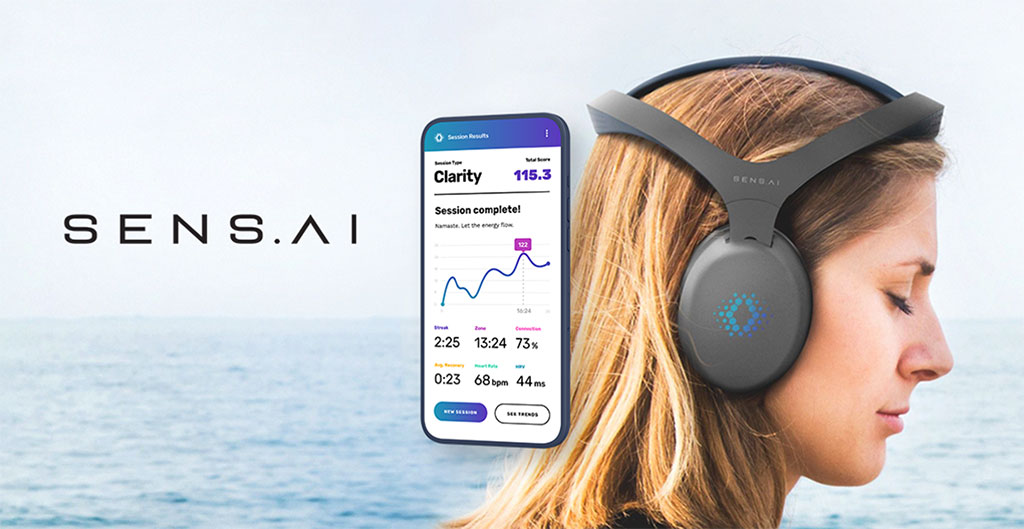
Sens.ai is the first wearable EEG headset to bring clinical-grade neurofeedback training to consumers to use at home.
It works to stimulate your brainwaves through both audio cues and light therapy helping you to train different states of mind and rewire your brain for better cognitive performance. It also integrates heart rate variability training for improving your nervous system functioning and sleep quality.
Their guided audio brain workouts are designed to help you strengthen your ability to meditate, reduce brain fog, and improve your memory. It is also the first wearable headset to offer gamma brainwave training, which can help synchronize your brainwave activity and improve your ability to focus.
Pros:
✅ The most advanced clinical-grade neurofeedback at a reasonable price
✅ Innovative photobiomodulation system using light therapy and audio cues
✅ Beautifully designed and the integrating training in the app looks great
Cons:
❌ A steep price tag but still much cheaper than clinical neurofeedback
❌ After many delays post-crowdfunding, it been out for less than a year
Price: $1199 on the Sens.ai website.
4. Enophone: EEG Monitoring Headphones
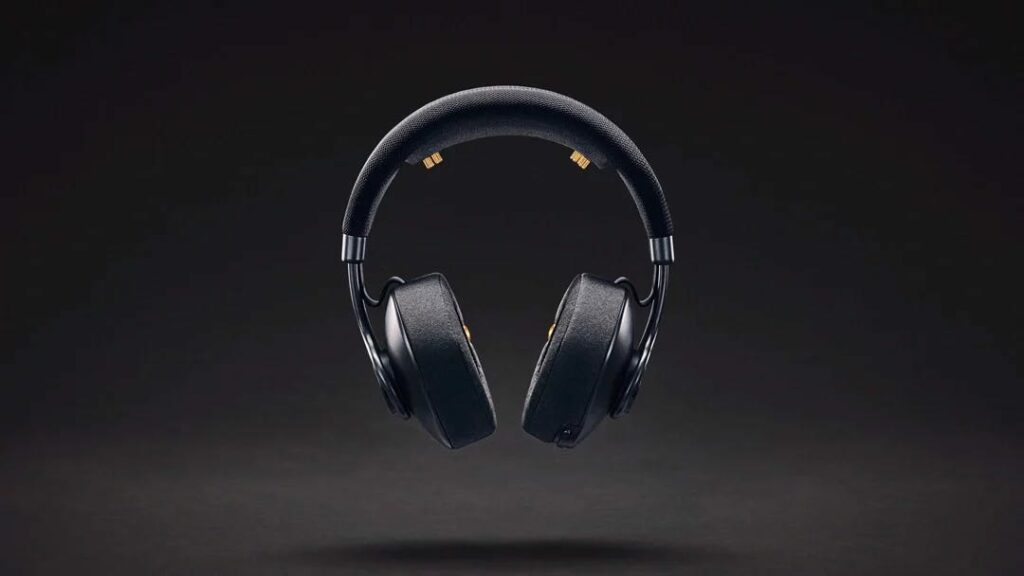
I’ve been waiting for a long time for a pair of noise-cancelling headphones that combined EEG activity monitoring to improve your focus and productivity. That’s the promise of Enophone.
Dubbed the “Fitbit For The Brain” by its Montreal-based founders Jacob Flood and David Doyon, the Enophones started as a promising crowdfunded wearable EEG headphones and I was rather disappointed when I heard the startup ran out of funding in the fall of 2022.
Fortunately, that wasn’t the end of the Enophone story. In the summer of 2023, this product was back to life when Moonshot.la scooped up the remaining assets and technology patents from the bankruptcy sale.
That’s means there is finally have a well-funded startup that is making wearable EEG headphones that can help knowledge workers get more focused and access more flow in their work.
They have excellent sound quality powered by Onkyo and a great design and build quality that makes them feel like premium active noise cancellation (ANC) headphones but there’s still a lot of work to be done to fully tap into the potential of the EEG technology built into these headphones.
In the meantime, they have a nice integration of brainwave entrainment music to access states of focus, flow, calm and sleep. I’m excited to see what the new developers add to these headphones.
✅ Premium active noise cancelling (ANC) headphones with sound by Onkyo
✅ Comfortable and easy to wear for long periods of time spent at work
✅ Integration of brainwave entrainment music in the new iPhone app
Cons:
❌ Over 7 years since the original Kickstarter campaign and still haven’t lived up to their promise
❌ The new iPhone app has just been released and they are no longer supporting the desktop productivity tracker
Price: $399 on their website
5. BrainTap: The Brain Fitness Headset
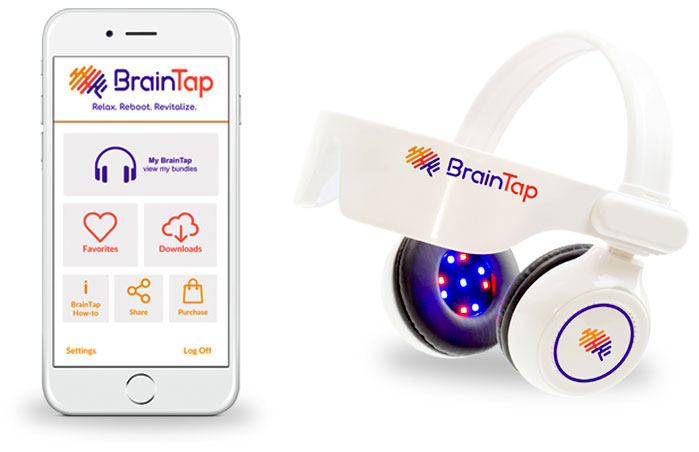
The BrainTap headset uses guided visualization along with LED light therapy and brainwave entrainment frequencies to shift your mind into a mental state where you feel energized, focused, and relaxed.
Launched in 2014 after decades of clinical neuropsychology research by its creator Patrick K. Porter, Ph.D. it includes over 1,800 guided audio programs that use binaural beats, isochronic tones, and 3D soundscapes.
The most interesting thing about this wearable EEG headset is that it helps you to retrain your brain to improve your body’s natural sleep pattern so you wake up feeling more refreshed each day. There have been a number of studies showing that using it can reduce jetlag and improve time spent in deep sleep.
This EEG headset seems a little expensive to me at $647 given the cheap plastic built quality and the fact that you need to pay an additional $10-30/month for the different subscriptions in their app.
Pros:
✅ If you’re suffering from insomnia, this might be the best option for you.
✅ Excellent selection of 3D soundscapes and brainwave entrainment music.
Cons:
❌ Cheap plastic built quality that feels a little fragile.
❌ Expensive and you have to pay an additional $12/month for the app.
Price:
Available for $647 on the BrainTap website.
The Future of Wearable Meditation Technology
It’s clear that we’re entering a new age of insight into ourselves, wearable technology and biofeedback are only going to continue to grow as new technology comes along.
Simply consider that while EEG has been around since the early 1900s, we’re at a point now where we can purchase our own devices, measure our brainwaves, and adjust our lives more effectively to deal with stress and improve our focus.
Whatever your choice of meditation headset, make sure you take full advantage of it. Life is full of stress and anxiety these days, so learning about yourself and how to overcome those problems better is going to make a huge impact on your health and happiness.

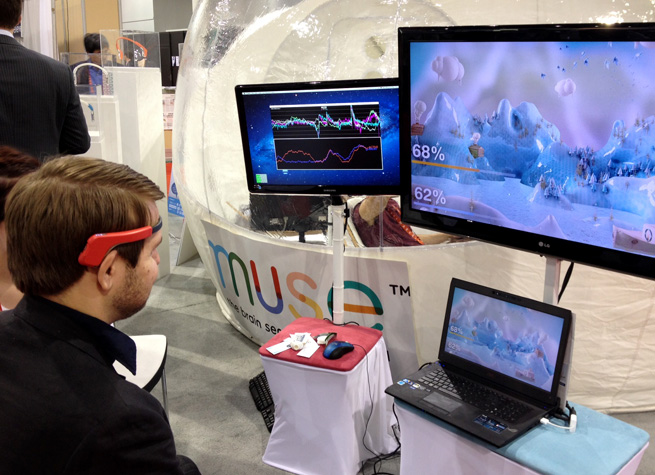
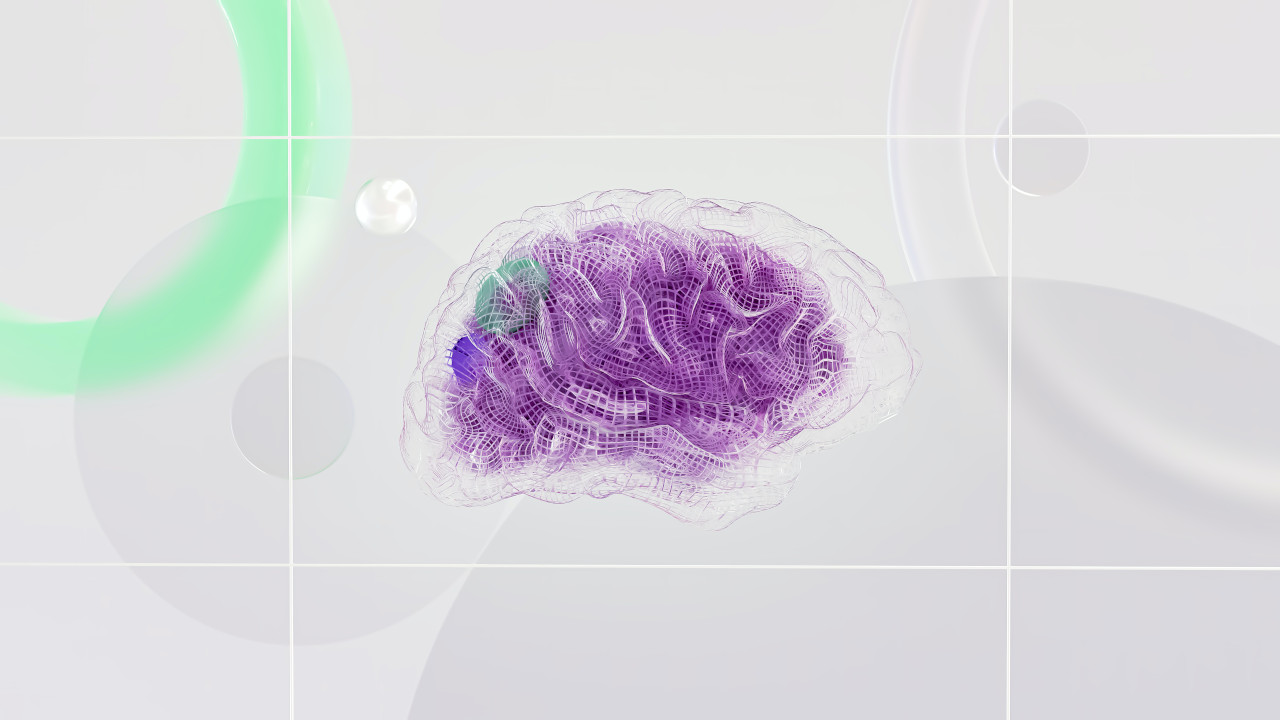
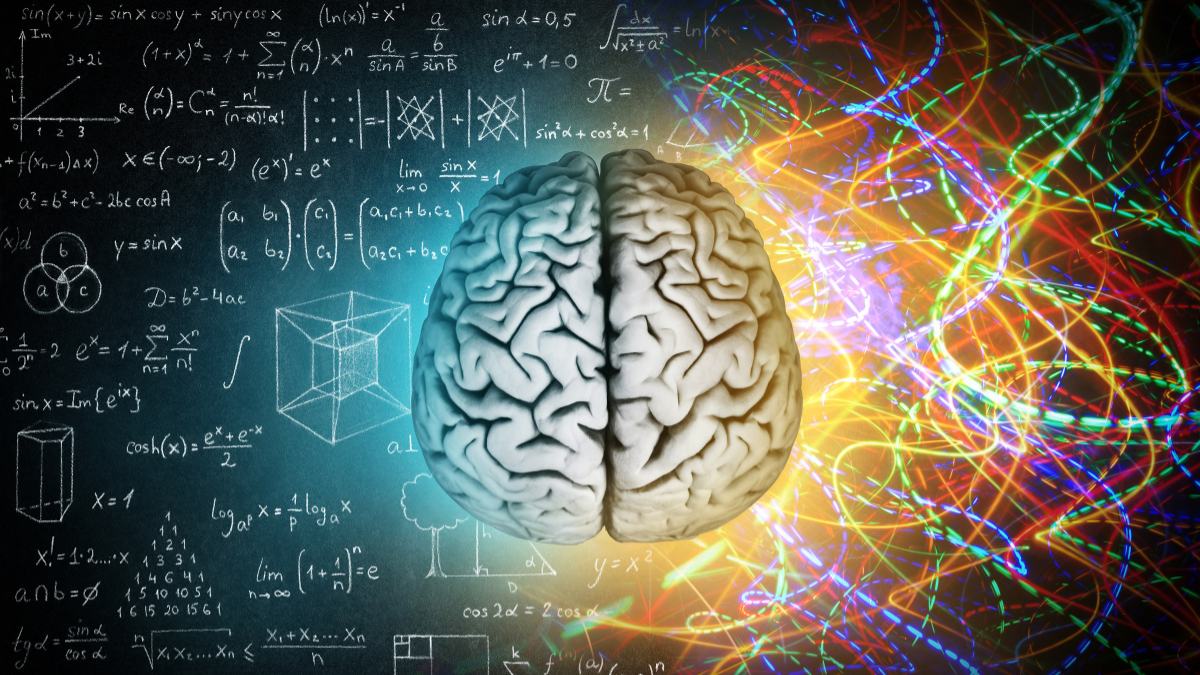
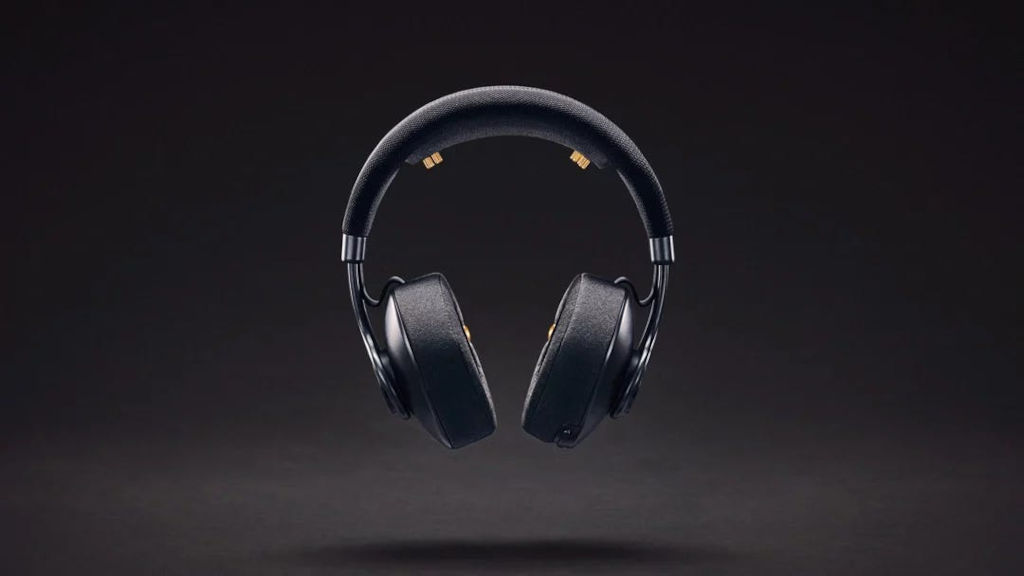
Why not just have an optional jack for those who do not want the harmful Bluetooth signal going through their brains?
Hi Pareen,
I’m surprised more of these device makers don’t do that. I think they lean toward convenience and Bluetooth makes it very easy to use.
The thing I dont like about any of these headsets is that they are bluetooth. So basically youre already frying your brain with damaging frequencies.
Hi Paul,
I’m not a big fan of Bluetooth signals passing through my brain tissue but the jury is out on whether low-energy Bluetooth signals actually cause long-term health problems.
I did some research on Apple’s Airpods and they synchronize together by sending signals back-and-forth from each AirPod through your brain. Some people get headaches from them, which suggests they aren’t so good and some health professionals are questioning how safe the technology is.
That beings said, Bluetooth is a weak signal compared to the 5G technology coming out and it’s also not nearly as bad for your health as having an unprotected smartphone in your pocket all day transmitting and receiving up to 800 signals a minute.
Hi Kyle, thanks for your reply. In all honesty, I dont need to know what the so called “experts say” as I’ve used a few different Bluetooth headers and they all give me a headache after about 30mins use. As an empath I am super sensitive to all things in my environment, so usually go based on that, then do research to understand my own findings. Yes 5G is terrible as you can tell by the forward thinking countries that have now banned it. A lot of people are experiencing depression, anxiety and trouble sleeping. It seems the main reason is to do with EMF, namely WiFi signals. Which is very interesting when your internet provider tells you to not ever switch off your network box with with no real reason why ?. I’ve been doing some research on faraday cages, which seem interesting. Anyway, if you do know any great wired headsets for Neuroglia feedback, I’d be very interested
Many thanks Paul
I’m surprised you didn’t mention Heart Math solution for meditation based on the HRV readings. Their highly sensitive Inner Balance sensor comes with a cool app and almost real-time data. It clips to your ear and surprisingly easy to use.
This post is more focused on brainwaves, I talk about HeartMath in this post: https://www.diygenius.com/meditation-and-heart-rate-variability-training/
I tried several of those gadgets including Muse and Procyon, but also so-called lucid dream such as REM Dreamer: they’re all funny to use, and perfectly ineffective, at least to me, a lucid dreamer “seeker”. The real breakthrough will be a device that can indeed change your brain waves, i.e. forcing your brain to “go alpha” for instance. I tried to do this with Muse with almost no success at all. We need more capable bio-feedback devices, and I am sure it will come one day.
Actually Carl, they already have that, its called BWE Brain Wave Entrainment. Varied success depending on individual and quality of the headphones, app and technique used. Research Binural Beats, iDose, tons of apps at Google and Apple. Essentially your “lassoing” your current brainwaves through audio differentials, then once you’ve “grabbed” your brains current frequency(s) resonance, you slowly bring down the app hertz….and your brain follows!
Is there a device that can actually ‘manipulate’ brain waves? i.e., alter brain waves to help a brain think another way? Perhaps this manipulation be used to actually re-train a brain to think a certain way, perform a certain way, achieve a certain task without the individual knowing it beforehand? (something like language training?). Think about this a minute, brain waves are just very weak electrical signals. That’s how we think, move, act, believe….everything. So why can’t a change of frequency, or electrical signal stimulate a brain in such a way, at the correct spot, and at a precise moment to influence a person to “know” something that a brain picks up naturally while developing, but didn’t think they knew? Just some out-loud thinking.
Interesting thoughts Timothy! I can’t think of any device that could do this but I hope someone is working to take this brainwave technology to the next level for rapid skill acquisition and boosting cognitive function.
Hello!
Does anyone know how to get Hz from numbers that gives me MyndPlayPro?
I use Neurosky Mobile 2, it records brain activities, then i transfer it into excel, get “attention”, “meditation” and numbers for brain waves. But in order to interprete brain activity i need to know Hz from those waves. On the site of Neurosky they put a formula that makes voltage out of numbers that you get in excel. I tried to ask them what are my next steps, they only said i need to do FFT and that’s it. It didn’t help me, so I’m looking for a way to get the exact Hz that were measured during a brain activity recording
Hi!
I had the NeuroSky MindWave Headset for a while, but the sensor for the forehead never touched my forehead as it should. Meaning it touched in an angle, so only an edged of the sensor touched my forehead, not the whole flat surface of the little metal square. I tried every possible adjustment, but none worked.
I had to hold it with a hand and bend the arm hard so the sensor square would touch my forehead completely with all its metal surface.
I got so frustrated that I did not even give it to someone else, as then someone else would feel just as frustrated. I just threw it in the waste bin for discarding electric appliances in the supermarket.
Maybe it would fit on a child’s head. It sure did not fit on my regular adult head.
Lodewijk Langeweg
Someone know from where can i get just the sensors for open source proyects? i want to place the sensors in an 3d printed design
Hi Jose, the place for that would be OpenBCI, it’s the best community I know of for DIY innovators hacking together 3D-printable EEG headsets.
Hi,
I’m a student, what is the cheapest headset for small project ?
The NeuroSky headset is the cheapest commercially available option I know of but if you’re looking for something more DIY, try out OpenBCI, which is a DIY EEG kit for hackers.
I am looking for a machine that will record dreams, Will this machine do that? If not do you know of a company that sells machines does that ? Charlie.
I haven’t heard of anything that can record dreams. Definitely, something that should be invented, if it’s possible.
Thank you for your straight forward reviews. As a past disappointed user of an inexpensive feedback head type device I wish I had seen your reviews before I purchased. Thanks again.
This is why we need regulations. A company can get a license and fool you into believing this works. I would love to have a tool like this to focus and see progress but these technologies needs some base rules and oversight. I would love to think people are just basically honest but there is already one post about a bad headset and that site was down while I am posting this. Its is impossible to clear your mind in the first place you do not know where the thoughts are coming from. Am I thinking or is it me and what is the difference between I and Me. Good post thanks for the research. Focusing thought in this day and age is vital, for the material world has made (me) lazy. Dont want to speak for all.
I use the low tech approach.
Brainwaves binaural beats application and a set of head phones. ..
I want a device to monitor 1/ brain wave 2/ eye motion 3/ body motion.
Is such a device available anywhere ?
Hi Ian, I’m interested in the same things you mentioned too, to monitor, has anyone responded to your post? I’m looking for something to wear at night to monitor REM and deep sleep stages.
Thanks Shannon
I tried the Neurosky headset. At first I thought I was measuring something. After a while, I started to get suspicious. So I shorted the headset together. I got the same result as I did when I was wearing it. Either the wave are manufactured or my brain is actually shorted.
Great work keep it up